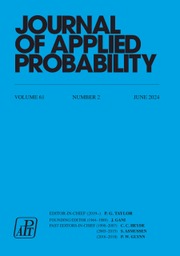No CrossRef data available.
Article contents
Two-type branching processes with immigration, and the structured coalescents
Published online by Cambridge University Press: 29 September 2025
Abstract
We consider a population consisting of two types of individuals, each of which can produce offspring on two different islands (in particular, the islands can be interpreted as active or dormant individuals). We model the evolution of the population of each type using a two-type Feller diffusion with immigration and study the frequency of one type on each island, when the total population size on each island is forced to be constant at a dense set of times. This leads to the solution of a stochastic differential equation, which we call the asymmetric two-island frequency process. We derive properties of this process and obtain a large population limit as the total size of each island tends to infinity. Additionally, we compute the fluctuations of the process around its deterministic limit. We establish conditions under which the asymmetric two-island frequency process has a moment dual. The dual is a continuous-time two-dimensional Markov chain that can be interpreted in terms of mutation, branching, pairwise branching, coalescence, and a novel mixed selection–migration term.
MSC classification
Information
- Type
- Original Article
- Information
- Copyright
- © The Author(s), 2025. Published by Cambridge University Press on behalf of Applied Probability Trust


